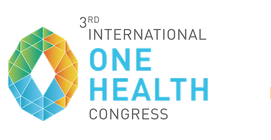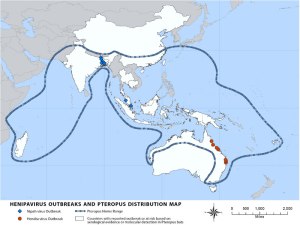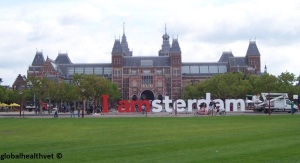 It’s been a great few weeks! I had two great opportunities to expand my knowledge on global health issues. The first was the 3rd International One Health Congress. I was then very lucky to attend a course called Engaging Intergovernmental Organizations where I visited many of the big organizations promoting global health (more on that soon).
It’s been a great few weeks! I had two great opportunities to expand my knowledge on global health issues. The first was the 3rd International One Health Congress. I was then very lucky to attend a course called Engaging Intergovernmental Organizations where I visited many of the big organizations promoting global health (more on that soon).
But first things first…the One Health Congress. The conference was held in Amsterdam between March 15th and 18th 2015 and I was presenting two posters about the current work I’m involved with about the epidemiology of local animal diseases and flea/tick distribution. I was looking forward to attending this conference because I had the chance to be a presenter at the 1st One Health conference (Click here for report of 1st One Health Congress in 2011).
The congress was once again a great forum to exchange ideas, current achievements of One Health and discuss where this movement should be headed. Over 800 participants came from all over the world to share their work in the field. From the sessions I attended, it seemed to me that a majority of them were researchers, university representatives and animal health professionals.
The topics discussed ranged from a recent Q-fever outbreak in the Netherlands, the control of neglected tropical & zoonotic diseases, and the need for more policies supporting the management of problems related to food security and zoonotic diseases. Of course the current Ebola outbreak in West Africa was also a major topic of discussion.
Bats, bats, bats…
A lot of focus was put on bats and their diseases. Many scientists are turning to bats to look for the next big pandemic. Previous studies have shown that bats can host more zoonotic viruses than many other mammals.
Some of those viruses fall under the henipavirus family. This group includes Hendra and Nipah viruses and there were great presentations summarizing the discovery of these two pathogens in the past decades.
Hendra started to stir up trouble in 1994 in Australia when it infected both horses and the people who cared for them (including veterinarians).

Bats from the Pteropus family can shed henipaviruses and have a wide distribution around the Indian Ocean (Image source)
Nipah virus is mainly known for 2 different outbreaks, the first one in Malaysia, where pigs were infected and passed on the disease to their handlers. A lot of discussion went into how a bat virus could have infected several pigs and in turn jump to humans. It turns out that, in that case, the pig farming facility was also a fruit plantation and that attracted a lot of fruit bats to the farm – a great environment for viruses to jump species.
Another Nipah virus outbreak was seen in Bangladesh and was transmitted directly from bats to people through contamination of date palm sap, which is commonly consumed in that region of the world. This is a great example of a low cost intervention that successfully managed this disease locally. Date palm sap is collected from the trees into jars that are left overnight. Fruit bats are also very fond of this drink and would drink from the jar throughout the night. By covering the jars with a layer of bamboo, people were able to prevent the bats from accessing and contaminating the jars.
There are several other viruses of importance that can be found in bats: rabies, influenza and coronaviruses (SARS, suspected MERS-CoV) and probably Ebola as well. That being said, bats play a crucial role in the environment and wiping them out (as some propose) would only disturb the ecosystem further and cause unforeseen consequences.
So where are we with this whole One Health thing?
I greatly enjoyed the conference, and learned tons of good stuff. A lot of the content focused on the “background One Health knowledge” (ex: showing how viruses can cross species barriers or how specific epidemics originated in animals). I left this conference with the same feelings as I did 3 years ago. I still feel that there is much discussion about how One Health would work and not enough practical applications.
For One Health to thrive and be understood, we need to demonstrate how resolving the some of the world’s issues from a multi-disciplinary approach result in more long lasting, sustainable and economical change.
Don’t get me wrong, I think that the conference participants highlighted some very important topics related to One Health and I think the next step is to put that knowledge into action.
I am afraid One Health is becoming more of a catchphrase used to attract attention, and without concrete evidence of its effectiveness, it might not last very long.
On the positive side, it was great to see people from all corners of the world show their passion of One Health and it only strengthened my resolve to enact my own practical applications of this concept. Wish me luck!
More interesting information

Thanks so much for this report. Was meant to be Amsterdam for the Conference, and was even given scholarship. But some local workplace issues distracted me.
I will go through it and will probably also post it to the OneHealthNigeria egroup and a couple of veterinary egroup I created/moderate here in Nigeria
Have a significant Easter. May you personally experience the resurrection power of the person Easter is all about- the Lord Jesus Christ!.
Kudos
Babalobi, Nigeria
On 4/4/15, Global Health Vet – A One Health approach to public health
By: tayobabalobi on April 4, 2015
at 15:18
[…] attending the One Health Congress, I had the opportunity to stay in Europe to participate in a program called Engaging […]
By: Engaging Intergovernmental Organizations workshop, 2015 | Global Health Vet - A One Health approach to public health on May 25, 2015
at 21:59